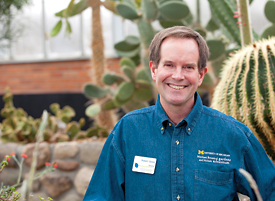More online
On a winter morning seven miles east of Central Campus, reddish-gold koi fish glide below sunlit water lilies in a tranquil mangrove pond, as warm mist settles on the green leaves of an 18-foot tamarind tree by a waterfall.
The setting is the Conservatory, the diverse greenhouse and centerpiece of Matthaei Botanical Gardens Celebrating 50 Years on Dixboro Road. The spring 2012 exhibit and display is presented through April 8.
“One of the statements Regent Fred Matthaei Sr. made when he donated the land was that he wanted the botanical gardens to be second to none in the world, so we want the public to see what progress we’ve made toward that goal,” says Robert Grese, director of the gardens and the Nichols Arboretum, and professor of natural resources, School of Natural Resources and Environment.
The exhibit reveals how Matthaei has grown to suit changing times. From a typical university botanical gardens focused on producing plant specimens for research, the botanical gardens has embraced a new role — that of a public facility offering activities to back learning, understanding and enjoyment of the natural world, and good health.

Robert Grese, director of the Matthaei Botanical Gardens and the Nichols Arboretum, stands among cacti in the Conservatory, the focus of an exhibit presented through April 8. Photo by Scott Soderberg, U-M Photo Services.
“We’ve encouraged collaboration involving a wide range of units around campus. Today we not only have biological and botany classes taught here, but a large number of art classes come out here to draw,” Grese says. The University Musical Society and the School of Music, Theatre & Dance co-produce musical events at the gardens, and Asian studies students come to view and study culturally important Asian plants. “We routinely have a number of projects with the College of Engineering, and we’ve also had a number of installations by Taubman College students and faculty to test design ideas.”
Further, Matthaei Botanical Gardens is nearly unique among U.S. universities for its unusually diverse range of plants on display. Grese says that’s because the 350-acre site hosts habitats ranging from an old growth oak forest to flood plain and wetland habitats. “We estimate our lands contain 20 percent of the state’s native flora, that’s an extremely high number for a botanical gardens. It makes us a very rich field teaching facility,” he says.
Grese says today there also is interest in the botanical gardens as a place to study how nature can impact people by promoting nature walks to reduce stress and general health.
Planting seeds
In the 19th century, universities maintained botanical gardens to train medical students who used plants to make medicine. The university maintained such a garden in an area between the President’s House and the Graduate Library. Grese says that after that garden fell to frequent trampling, the decision came in 1906 to relocate the gardens to what is now the Nichols Arboretum site on Geddes, and then to Iroquois Street near Industrial Highway and Stadium Boulevard around 1914.
By the mid-1950s, development began to crowd greenhouses on that site, and drainage problems surfaced. Matthaei responded with an offer to donate 200 acres along Dixboro Road east of Ann Arbor and the money to buy an adjacent 100 acres. The site ultimately grew to today’s approximate 350 acres.
Alden Dow, the architect laureate for Michigan known for designing churches, libraries, other public buildings and private homes, designed the main building housing the conservatory. “Some people compared his design to a church, with a long central hallway down the middle,” Grese says. By the 1970s, director Herbert Wagner was expanding community learning at Matthaei, helping to set in motion its evolution to that of a more public facility.
50th celebration
For exhibit-goers, new descriptor cards have been placed through the conservatory to identify key historical plants. They include the nearly 10-foot wooly torch cactus collected by botany professor Elzada Clover in 1946 in El Rancho, Guatemala. Clover collected several plant specimens still on display.
Photographs telling the story of the gardens over 50 years also are being displayed in the conservatory during the exhibit. There is a spring bulb and flower display, and an invitation to record and share memories of the gardens. There also is a presentation on research by Mojtaba Navvab, associate professor of architecture, on what it takes to design plant friendly lights and buildings.
Grese says upcoming Matthaei 50th anniversary projects this year will include the creation of a new garden celebrating Great Lakes flora, including orchids and wildflowers, and another garden to display its collection of bonsai and penjing.

